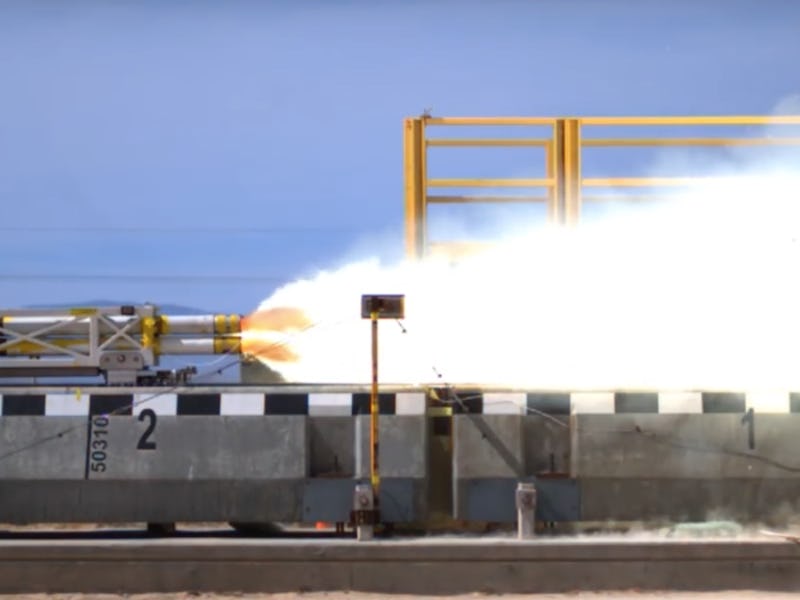The Air Force's 633 mph Maglev Sled Reignites Hope for American High Speed Rail
Engineers are rapidly approaching the speed of sound on a high-tech test track in New Mexico.

Seven football fields in two seconds. That’s how much distance a rocket-powered sled covered last month in a test run that broke the world record for speed on a magnetically levitated track. The 2,100-foot-long track is at Holloman Air Force base in New Mexico, home to the 846th Test Squadron. The team behind the magnetic levitation system was able to push their sled to reach a top speed of 633 miles per hour, besting their previous world record of 513 mph set two days earlier.
The 2,000-pound sled accelerated at a mind-boggling rate of 928 feet per second down the nearly frictionless surface of the track, which the engineers “smoothed” by cooling the magnets to four degrees Kelvin using liquid helium.
The motto of the 846th is “go Mach 10.” With their latest achievement, they’ve gotten closer than ever to breaking the sound barrier, Mach 1, or 761.2 miles per hour. For context, Elon Musk’s much hyped hyperloops claims that they’ll be capable of hitting 700 mph. But it’s important to understand these aren’t competing technologies. There is very little difference between Hyperloops and maglev trains, aside from who makes them. Hyperloops are essentially maglev trains in vacuum tunnels designed to reduce air pressure and drag. Still, it always matters who makes things and the dearth of coverage around the New Mexico trials is indicative of an almost inexplicable American disinterest in maglev-style high-speed rail.
Magnetic levitation is responsible for the fastest and smoothest public transit trains in the world. The fastest of the lot runs is in Japan, where a seven-car train went one mile in 11 seconds in April of last year. That’s 375 mph. “The ride was comfortable and stable,” Yasukazu Endo, the head of the Maglev Test Centre, told the Asahi Shimbun. That is — it is worth noting — creeping up towards the speeds at which the Hyperloop becomes problematic on a physiological level.
How do these commercial trains work? “A maglev’s guideway has a long line of electromagnets. These pull the train from the front and push it from behind,” The Guardian explains. “The electromagnets are powered by controlled alternating currents, continually propelling the train forward.”
American proponents of maglev technology, which uses electromagnets powered by alternating currents to push trains, have been lobbying for a New York City-Washington, DC connection for some time. A company called The Northeast Maglev is behind much of the push, in conjunction with Central Japan Railway, which runs a maglev line between Tokyo and Osaka.
In late 2015, Maryland Governor Larry Hogan announced his state would receive $27.8 million in federal funds to support the creation of a high-speed maglev train between Washington, DC and Baltimore. Much of the funding would also come from the Japanese government, which pledged to pay half of the estimated $9.75 billion total cost. The Northeast Maglev vision is simple if elaborate: trains running the entire Northeast corridor, making stops in Philadelphia and at the Newark International Airport, and cutting the time from NYC to DC to under an hour.
Maglev trains, and high-speed trains in general, have limited political support in the U.S., because the necessary infrastructure is incredibly expensive. In 2011, Vice President Joe Biden promised a $53 billion investment in high speed rail over six years. As of now, the government has spent $11 billion, which is a lot, but nowhere near $53 billion, even with a new $27.8 million grant.
Because it is such a powerful technology, there are all kind of fantastical maglev ideas floating around. The wildest of the bunch? A project called Startram envisioned using maglev to launch cargo tanks into outer space out of a tube on the side of a mountain. That’s not going to happen anytime soon, but as engineers continue to break new speed records with existing technology, the promise of wide-spread, super-fast maglev trains becomes hard to ignore.
It’s one thing for the government to break a promise to the American people. It’s quite another for them to ignore potentially valuable military technology. The U.S. Government has a history of doing the former, not the latter, which means that the 846th Test Squadron may be our best hope for superfast trains.